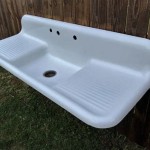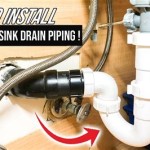Understanding the Kitchen Sink Shut-Off Valve
The kitchen sink shut-off valve is a crucial component of a home's plumbing system. It serves as an isolation point, allowing homeowners or plumbers to stop the water supply directly to the sink without affecting the water flow to the rest of the house. This localized control is invaluable for various plumbing tasks, ranging from minor repairs to complete faucet replacements. Understanding the function, location, and types of shut-off valves associated with a kitchen sink is essential for responsible home maintenance and emergency preparedness.
These valves are typically small, often made of chrome, brass, or plastic, and are installed on the water supply pipes located beneath the sink. There are generally two shut-off valves for a standard kitchen sink: one for the cold water supply and one for the hot water supply. These valves are designed for repeated use, allowing occupants to quickly shut off the water in case of a leak or other plumbing issue. Without these valves, a plumbing emergency at the sink could necessitate shutting off the main water supply to the entire house, causing unnecessary inconvenience and potentially disrupting other household activities.
The presence of properly functioning shut-off valves beneath the kitchen sink is not merely a convenience; it is a fundamental safety feature. A leaking faucet, a burst supply line, or a damaged drain can quickly escalate into a significant water damage event. Having accessible and operational shut-off valves allows for a swift response, minimizing the amount of water released and preventing potentially costly repairs to floors, walls, and cabinets.
Locating the Kitchen Sink Shut-Off Valves
The first step in utilizing the kitchen sink shut-off valves effectively is knowing where to find them. In most residential kitchens, these valves are located directly beneath the sink, within the sink cabinet. They are usually attached to the water supply pipes that lead up to the faucet. The hot water valve is typically located on the left side (when facing the cabinet), while the cold water valve is on the right, although this configuration may vary depending on local plumbing codes and the original installation. It's advisable to visually inspect the area under the sink upon moving into a new home to confirm the location and condition of these valves.
The appearance of the shut-off valves can differ slightly depending on the type and the age of the plumbing system. Some valves have a handle that needs to be turned, while others have a slot that requires a screwdriver to operate. The valves may be partially obscured by cleaning supplies, garbage disposals, or other items stored in the cabinet. It is crucial to keep the area around the shut-off valves clear and accessible to ensure quick access in an emergency. Furthermore, routinely checking the valves for signs of corrosion or leaks can help identify potential problems before they escalate.
If difficulty is encountered in locating the valves, look closely at where the faucet supply lines connect to the plumbing. The shut-off valves will be inline between these connections and the main water supply pipes coming from the wall or floor. In older homes, the valves may be hidden behind a panel or within a more enclosed space. In such cases, a flashlight and careful examination of the area may be necessary to pinpoint their location.
Types of Kitchen Sink Shut-Off Valves
Several types of shut-off valves are commonly used for kitchen sinks, each with its own mechanism and characteristics. Understanding the different types can help in identifying the valve under the sink and knowing how to operate it correctly. The most common types include compression valves, ball valves, and quarter-turn valves.
Compression Valves: Compression valves are a traditional type of shut-off valve. They operate by compressing a rubber or plastic sleeve against the water pipe to stop the flow. These valves typically have a multi-turn handle that needs to be rotated several times to fully open or close the valve. Compression valves are generally reliable, but the internal components, such as the rubber sleeve, can deteriorate over time, leading to leaks. When a compression valve starts to leak, it may require tightening or complete replacement.
Ball Valves: Ball valves utilize a ball with a hole drilled through it. When the valve is open, the hole aligns with the water pipe, allowing unimpeded flow. When the valve is closed, the ball is rotated 90 degrees, blocking the water flow. Ball valves are known for their durability and reliability. They are usually operated by a lever that provides a clear visual indication of whether the valve is open or closed. A primary advantage of ball valves is that they offer a full and unrestricted water flow when open and a complete shut-off when closed. They are also less prone to leakage compared to some other valve types.
Quarter-Turn Valves: Quarter-turn valves are a variation of ball valves that require only a 90-degree turn of the handle to fully open or close the valve. These valves are considered very user-friendly, particularly in emergency situations where a quick shut-off is critical. They are known for their ease of operation and visual indication of the valve's position. Quarter-turn valves are becoming increasingly popular in modern plumbing installations due to their simplicity, reliability, and ease of maintenance. Like ball valves, they provide full flow when open and positive shut-off when closed.
In addition to these common types, other less frequently used valves may be encountered, such as gate valves or globe valves. However, these are less common in residential kitchen sink applications due to their larger size and less efficient flow characteristics compared to ball and quarter-turn valves.
Maintaining and Replacing Kitchen Sink Shut-Off Valves
Proper maintenance of kitchen sink shut-off valves is essential to ensure they function effectively when needed. Regular inspection and occasional exercising of the valves can prevent them from seizing up or corroding. Ideally, valves should be turned on and off at least once or twice a year to keep the internal mechanisms moving freely. This simple action can help prevent mineral buildup and corrosion that can make the valves difficult or impossible to operate during an emergency.
Signs that a shut-off valve needs replacement include visible corrosion, leaks around the valve body or handle, difficulty turning the valve, or a failure to completely shut off the water flow. If any of these issues are present, it is advisable to replace the valve as soon as possible to avoid potential water damage. Attempting to force a stuck or corroded valve can damage it further and potentially cause a leak. It is also prudent to replace older valves as part of a routine plumbing maintenance schedule, even if they appear to be functioning adequately, as their lifespan is limited.
Replacing a shut-off valve is a relatively straightforward plumbing task that a homeowner with basic plumbing skills can often perform. However, it is essential to take precautions and follow proper procedures to avoid water damage. The first step is to shut off the main water supply to the house. Next, disconnect the water supply lines from the faucet and the existing shut-off valve. The old valve can then be removed, and the new valve installed using pipe joint compound or Teflon tape to ensure a watertight seal. Finally, reconnect the water supply lines and turn on the main water supply, checking for any leaks around the new valve and connections.
If uncertainty exists about the process of replacing a shut-off valve, or if the plumbing system is complex, it is always best to consult with a qualified plumber. A professional plumber can quickly and efficiently replace the valve, ensuring that it is properly installed and that the plumbing system is functioning correctly. They can also identify any other potential plumbing issues and provide recommendations for maintenance or repairs.
When selecting a replacement shut-off valve, it is important to choose a valve that is compatible with the existing plumbing system and that meets local plumbing codes. Consider the type of valve, the materials it is made from, and its overall quality. Opting for a higher-quality valve can often provide greater reliability and a longer lifespan than a cheaper alternative. Also, make sure the valve is the correct size to match the existing water pipes.
Following the replacement of any plumbing components, it is essential to monitor the area closely for any signs of leaks or other problems. This vigilance can help prevent minor issues from escalating into major water damage events. Regularly inspecting the plumbing system and addressing any concerns promptly can help maintain a safe and efficient home.
In conclusion, kitchen sink shut-off valves are a critical component of a home's plumbing system that provide a means of isolating the water supply to the sink. Understanding their location, types, and maintenance requirements is essential for responsible homeownership and emergency preparedness. Regular inspection, occasional exercising, and timely replacement of worn or damaged valves can help prevent costly water damage and ensure the efficient operation of the plumbing system.

How To Install Water Shutoff Valves In Kitchen Sink 1 4 Turn Valve Youtube

Adding Sink Shutoff Valves This Old House

How To Install Shut Off Valves The Home

How To Remove Install A Leaky New Shut Off Valve Compression Soldered Or Push Fit Got2learn Youtube

Types Of Water Shut Off Valves The Home

How To Rebuild A Shut Off Valve The Home

Accessible Water Shut Off Valve And A New Sink Your Plumber Heating Air

How To Replace A Shutoff Valve Diy Family Handyman

Plumbing Hot Water Supply Line Stopped Home Improvement Stack Exchange

Install Shut Off Valve Under Sink Replace Faucet Mobile Home Repair







